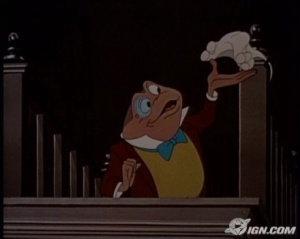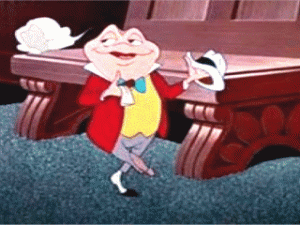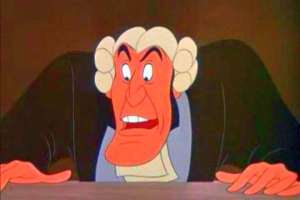44. The Trial(Ichabod and Mr. Toad)
Movie: The Adventures of Ichabod and Mr. Toad
Year: 1949
Key Players: Jim Bodrero (Early Development), Jack Kinney(Director), Charles Philippi(Layout), Ollie Johnston, Hugh Fraser, Eric Larson, Rudy Larriva, Marc Davis, Judge Whitaker, Harvey Toombs(Animators)
The Wind and the Willows segment in Ichabod and Mr. Toad is one of the most imaginative and wittiest products the Disney studio has ever made. “Wind and the Willows is one of the studio’s neatest cartoon efforts,” wrote Leonard Maltin in his book Of Mice and Magic. “Like all great Disney films, this one artfully built a believable set of characters and situations on a fantasy foundation. What’s more, the film adhered a consistent point of view, telling the story of J. Thaddeus Toad and his adopted horse, Cyril, with imagination and wit.” In my book the high point of the Wind and the Willows segment is the trail sequence. This scene has great acting, rich characterization, and its tongue-and-cheek treatment is very entertaining. This scene is number 44 on our countdown and is the subject of today’s post.
The idea for making a feature out of Kenneth Grahame’s Wind and the Willows came from Jim Bodrero, a member of Joe Grant’s model department during the 1940s. “I had read the book,” stated the artist in an interview with Milt Gray. “I wanted to do it, a long time before Walt. Walt thought it was awfully corny, but we finally got him around to it.”Him and fellow model department member Campbell Grant (best known for the visual development work he did for the Night on Bald Mountain segment in Fantasia) put together a Lucia reel going over the story and characters. “Campbell Grant and I did Wind in the Willows, in which we started a new technique, Bodrero told Gray. “It was the beginning of [limited] animation, you might say, because instead of showing a storyboard, we flicked over storyboard stills, to the dialogue. That was so impressive that the studio audience applauded.” I’ve seen very little of the work done on that version but from what I’ve seen it looked stupendous. Jim’s model sheets of Toad in particular were very influential in this sequence and even some of the poses used in the final version came from it. He was the one who defined the character and the movie was going to be his baby. Wind and the Willows was scheduled to be done as a low-budget feature, which makes sense because just that year Dumbo had been done for less than a million dollars but had a quality and substance in texture that almost no other Disney film has ever achieved. The success of Dumbo encouraged more low-budget films to be made putting this one on the pipeline. Animators coming off of Bambi such as Frank Thomas, Ollie Johnston, and Eric Larson were put on the feature and over 3,000 feet of animation had been done by the time Walt Disney himself decided to shelve it. The quality wasn’t strong enough to impress the boss and the idea of making low-budget features was canned.
Around 1947 the idea of Wind and the Willows was brought back but this time as part of the double feature, Ichabod and Mr. Toad. However the film’s creator, Jim Bodrero, had been one of the victims of the brutal 1946 post-war layoffs. It was a tragic departure and the man who was so devoted to the studio never got a chance to work there again. This time around Jack Kinney, famous for directing Goofy shorts, was put on as director. The treatment of the story was however quite a bit different than the work that had been done before World War II. “They broadened it a great deal and got further away from the original drawings,” resentfully remember Bodrero. “We stayed much closer to the book. I don’t think they did a very good job with it. I think it was better when Campbell Grant and I just had the flip-stills.”
Story wise the strongest part of this scene is the characterization. Every character in this scene has a distinct personality and a very different attitude. J. Thaddeus Toad is an interesting character because he tries to act like he’s very sophisticated and formal but really is completely eccentric and irrational. While there are quite a few crazy characters in Disney history he’s unique because he thinks he’s reasonable and intellectual. He is very into himself and has complete confidence that he can outsmart anyone he comes across. In reality this is all an act and nobody buys the persona. This put a huge challenge on the animators (most of the stuff on Toad here was done by Ollie Johnston and Eric Larson) to convey this complexity and to keep all these things in mind when animating. The result is exceptional and you can tell Toad is arrogantly “faking” the person he is. You can see this in the way he walks communicates this and the way he acts captures this tone. That’s something this scene does very well: it captures the tone of the acting so successfully in all of the characters. You know what types of personalities these characters are and you can see it in how they react to the emotions in the air of the situation. For example Toad acts arrogantly, Mcbadger acts worried, Ratty acts seriously, Moley acts innocently, the Defense Attorney acts rudely, and Mr. Winky acts cummingly. This is taken a step further because one thing I’ve noticed is the way the different characters move their arms is telling of this tone. For example Toad moves his arms with forced grace and with a confident assurance of himself. On the other hand the defense attorney moves his arms at a contrasting pace. Often he will start moving them precisely but then abruptly he’ll turn and point at someone. I like it when films find these themes in the acting that tell it all and particularly like the atypical one they chose to use here. Another great thing about the characterization here is there is an excellent contrast between the different characters. For example Moley is very friendly and light-hearted while Ratty is taking the situation seriously and is reacting to the trail in a sharp, intellectual way. The character designs here are very expressive and allow for the animation to take advantage of the rich personalities that come out from the story department. Last the dialogue here is well-written and is specific to the character that is speaking. However there are a few weak spots to the story here that prevent this scene from being as good of a moment as it can be. That is that this scene hasn’t been built up to well and the character relationships haven’t been well structured. What I mean is that the relationships don’t have enough complexity, development, or establishment for this to be a strong moment emotionally. This is unfortunate and part of me wishes Wind and the Willows was made as a feature to build on the rich material done here.
All the layouts in this scene are done by Charles Philippi, one of the first great layout artists in Disney history. His stuff is a bit on the sparse, some-what realistic side but it’s very graphic and has a thick vitality to it. “I remember Ken O’Connor saying that Charles could start at one end of the paper and just start drawing, practically writing out rocks and trees,” remembers Mark Kirkland. “It was so fantastic.” Here however layout takes a back seat because this scene is all about character and performance. Also another thing worth noting is the values of the color palette in the scene are very subtle and rarely are the colors particularly bright. Overall the entire movie is a bit dimmer in color than most Disney films, including the Sleeping Hallow part later.
Probably the most memorable piece of animation in this section is Ollie Johnston’s phenomenal District Attorney. The characters is entertaining because he’s flamboyant, opinionated, and abrupt. It’s in all respects a stellar performance and in my mind was one of his greatest achievements at the studio. “He was the first character I really had all by myself of any importance,” stated the animator. “I loved doing him even though there weren’t too many scenes; butt he was a real egotistical guy who had nothing but contempt for everybody that got on the witness stand. He’d laugh at them, make fun of them, and I got this great way of having him walk and then whirl on the character.” This strong analysis shows in Johnston’s animation and the effect he describes is a great touch. The walk shows not only that he’s arrogant but that he hates everyone there and doesn’t listen to a word they say. A brilliant secondary action added to that is the motion he does with his hands on the whirl. The fact that the whirl is so abrupt communicates the fact that he doesn’t care at all about anyone else and is too caught up in himself to bother to listen. A must have on your freeze-frame list is the scene where the D.A. is asking a question to McBadger. The arc of action in the gesture is amazing as well as the contrast in the timing. At first his walk is very precise but then it suddenly goes into a whirl. Not only is the timing of the motion well done but the action and staging are incredibly clear. Another shot I like a lot is the one where he’s laughing at the idea Toad would sell his home for a motorcar. All of Ollie’s animation here is so fluid and appealing to look at. I particular admire the texture of timing and acting he gives all of his characters throughout this sequence. Johnston also does some great stuff of Toad, Ratty, and Moley at the beginning. A particularly good part is where Moley waves at Toad but then Ratty puts his hand down to make him stop. Marc Davis also does some good stuff with Ratty, Moley, and Mcbadger later in the sequence.
While Ollie Johnston and Rudy Larriva also do some of Toad, the key acting scenes of him are done primarily by Eric Larson. His stuff here is very well timed as always and captures the personality of the character perfectly. “I guess Toad was one of my favorites,” admitted Larson in a television interview. “I think some of the most enjoyable actions I was ever able to get on the screen was Toad’s defense of himself in court. I felt that I did get a tone that is the peak of arrogance in that figure of action, in that particular bit of business.” Although I feel Eric is one of the weaker draftsmen of the top Disney animators he is so great at making a character believable and at putting their spirit on the screen. Sadly he for some reason didn’t get a screen credit at all on the film, which is a pity because it is very much deserved.
Almost all of the scene illustrating Cyril’s story is done by Hugh Fraser, an unsung animator who alongside John Lounsbery often worked closely with Norm Ferguson. “Hugh loved animating at Disney, he was a great guy,” remembers Tim Walker, who worked with him at Hanna-Barbara. “He was a solid animator who could animate anything. He was a good draftsman who could move anything around.” His stuff here has sharp timing and there is a cohesive feel to his acting. I particularly admire the stuff he did on the weasels. Fraser’s animation feels spontaneous and is strong in action. The animation of Cyril on the podium is a combination of Judge Whitaker and Harvey Toombs. Whitaker animates the horse with a lively feel and his animation is without question rather appealing. Cyril has great charisma in those shots and has a nice New Yorker flavor to his acting. Toombs comes in when he says “The only way a gentleman does- the honest way.” His draftsmanship is distinct because he usually draws elongated snouts/noses and his animation has a skeletal, three-dimensional volume. Harvey’s animation on this film is in my opinion the best work he ever did at the studio (with his work on the elephants in the Dance of the Hours being a close second) and this scene gave him a great opportunity to prove his acting skills.
Last Mr. Winky is handled by Ollie Johnston and Rudy Larriva. I love how cunning of a character he is and find his atypical attitude to be intriguing. A nice touch is the clumsy, duck walk he has. Here animator Barry Temple has some comments on a brilliant shot done by Ollie: “One of my favorite scenes of all time is the scene in Wind in the Willows of Mr. Winky perjuring himself on the witness stand, where he casually reaches into his pocket and pulls out a rag that bartenders use to continuously wipe the spilled beer, which gave away his occupation as he wipes down the witness stand. It showed the audience that he was calm and collected, completely comfortable with lying, and gleefully helping to send an innocent Toad to prison. I don’t know if it was storyboarded that way, or if it was created during the animation process between the director and animator.”
I love this scene because of how witty and imaginative it is. It takes full advantage of the medium of cartoon animation and I find a million ideas in it. The animators solve problems here in creative, unique ways and I find it makes the scene richer and more appealing. Also I love the characterization here and admire how that is taken a step further with genius performances by the animators. Last I like the fast timing and satirical tone in the acting done here. This scene is a great one and I give sincere thanks to everyone who helped make it possible.
Bibliography
My Interview with Barry Temple
My Interview with Mark Kirkland
My Interview with Tim Walker
Milt Gray’s Interview with Jim Bodrero
John Canemaker’s Interview with Ollie Johnston
The Nine Old Men and the Art of Animation by John Canemaker
Hollywood Cartoons by Michael Barrier
Of Mice and Magic by Leonard Maltin
Before the Animation Begins by John Canemaker
The Illusion of Life by Frank Thomas and Ollie Johnston










July 3, 2012 at 9:09 am
That close up of Winky is fantastic.